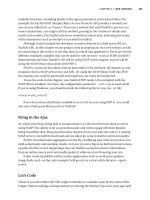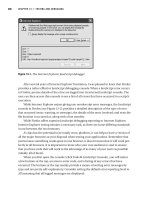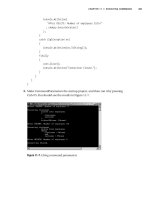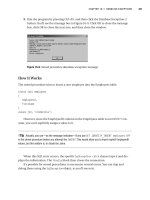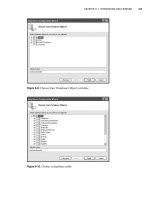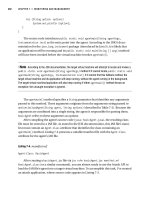Beginning PHP and MySQL From Novice to Professional phần 6 ppt
Bạn đang xem bản rút gọn của tài liệu. Xem và tải ngay bản đầy đủ của tài liệu tại đây (1.67 MB, 108 trang )
506
CHAPTER 20
■ WEB SERVICES
Ultimately, only one metric will determine the success of Web Services: acceptance.
Interestingly, several global companies have already made quite a stir by offering Web
Services application programming interfaces (APIs) to their treasured data stores. Among
the most interesting offers include those provided by the online superstore Amazon.com,
Google, and Microsoft, stirring the imagination of the programming industry with
their freely available standards-based Web Services. Since their respective releases, all
three implementations have sparked the imaginations of programmers worldwide, who
have gained valuable experience working with a well-designed Web Services archi-
tecture plugged into an enormous amount of data.
Follow these links to learn more about these popular APIs:
• />• />• />Really Simple Syndication
Given that the entire concept of Web Services largely sprung out of the notion that
XML- and HTTP-driven applications would be harnessed to power the next genera-
tion of business-to-business applications, it’s rather ironic that the first widespread
implementation of the Web Services technologies happened on the end-user level.
RSS solves a number of problems that both Web developers and Web users have
faced for years.
All of us can relate to the considerable amount of time consumed by our daily surfing
ritual. Most people have a stable of Web sites that they visit on a regular basis—in
some cases, several times daily. For each site, the process is almost identical: visit the
URL, weave around a sea of advertisements, navigate to the section of interest, and
finally actually read the news story. Repeat this process numerous times, and the next
thing you know, a fair amount of time has passed. Furthermore, given the highly
tedious process, it’s easy to miss something of interest. In short, leave the process to
a human and something is bound to get screwed up.
Gilmore_862-8C20.fm Page 506 Friday, February 15, 2008 7:05 AM
CHAPTER 20 ■ WEB SERVICES
507
Developers face an entirely different set of problems. Once upon a time, attracting
users to your Web site involved spending enormous amounts of money on prime-
time commercials and magazine layouts, and throwing lavish holiday galas. Then the
novelty wore off (and the cash disappeared) and those in charge of the Web sites were
forced to actually produce something substantial for their site visitors. Furthermore,
they had to do so while working with the constraints of bandwidth limitations, the
myriad of Web-enabled devices that sprung up, and an increasingly finicky (and time-
pressed) user. Enter RSS.
RSS offers a formalized means for encapsulating a Web site’s content within an
XML-based structure, known as a feed. It’s based on the premise that most site infor-
mation shares a similar format, regardless of topic. For example, although sports,
weather, and theater are all vastly dissimilar topics, the news items published under
each would share a very similar structure, including a title, an author, a publication
date, a URL, and a description. A typical RSS feed embodies all such attributes, and
often much more, forcing an adherence to a presentation-agnostic format that can in
turn be retrieved, parsed, and formatted in any means acceptable to the end user,
without actually having to visit the syndicating Web site. With just the feed’s URL, the
user can store it, along with others if he likes, into a tool that is capable of retrieving
and parsing the feed, allowing the user to do as he pleases with the information. Working
in this fashion, you can use RSS feeds to do the following:
• Browse the rendered feeds using a standalone RSS aggregator application. Exam-
ples of popular aggregators include RSS Bandit (
Straw ( and SharpReader (http://
www.sharpreader.net/). A screenshot of RSS Bandit is shown in Figure 20-1.
• Subscribe to any of the numerous Web-based RSS aggregators and view the
feeds via a Web browser. Examples of popular online aggregators include
Google Reader ( NewsIsFree (http://
www.newsisfree.com/), and Bloglines ( />• Retrieve and republish the syndicated feed as part of a third-party Web applica-
tion or service. Later in this section, you’ll learn how this is accomplished using
the MagpieRSS class library.
Gilmore_862-8C20.fm Page 507 Friday, February 15, 2008 7:05 AM
508
CHAPTER 20
■ WEB SERVICES
Figure 20-1. The RSS Bandit interface
WHO’S PUBLISHING RSS FEEDS?
Believe it or not, RSS has actually officially been around since early 1999, and in previous incarna-
tions since 1996. However, like many emerging technologies, it remained a niche tool of the “techie”
community, at least until recently. The emergence and growing popularity of news aggregation
sites and tools has prompted an explosion in terms of the creation and publication of RSS feeds
around the Web. These days, you can find RSS feeds just about everywhere, including within these
prominent organizations:
• Yahoo! News:
/>• The Christian Science Monitor: />• CNET News.com: />Gilmore_862-8C20.fm Page 508 Friday, February 15, 2008 7:05 AM
CHAPTER 20 ■ WEB SERVICES
509
• BBC: />• Wired.com: />Given the adoption of RSS in such circles, it isn’t really a surprise that we’re hearing so much
about this great technology these days.
Understanding RSS Syntax
If you’re not familiar with the general syntax of an RSS feed, Listing 20-1 offers an
example, which will be used as input for the scripts that follow. Although a discussion
of RSS syntax specifics is beyond the scope of this book, you’ll nonetheless find the
structure and tags to be quite intuitive (after all, that’s why they call it Really Simple
Syndication).
Listing 20-1. A Sample RSS Feed (blog.xml)
<?xml version="1.0" encoding="iso-8859-1"?>
<rss version="2.0">
<channel>
<title>Inside Open Source</title>
<link> /> <item>
<title>Killer Firefox Tip #294</title>
<link> /> <author>W. Jason Gilmore</author>
<description>Like most of you, I spend bunches of time downloading large
files from the Web, typically podcasts and PDF documents…</description>
</item>
<item>
<title>Beginning Ubuntu Linux wins Linux Journal Award!</title>
<link> /> <author>Keir Thomas</author>
<description>Woo hoo! My book, Beginning Ubuntu Linux, has won an award
in the Linux Journal Editor's Choice 2006 awards!
More precisely…</description>
</item>
Gilmore_862-8C20.fm Page 509 Friday, February 15, 2008 7:05 AM
510
CHAPTER 20
■ WEB SERVICES
<item>
<title>Forms Validation with CakePHP</title>
<link> /> <author>W. Jason Gilmore</author>
<description>Neglecting to validate user input is akin to foregoing
any defensive
gameplan for containing the NFL's leading rusher. Chances are
sooner or later…</description>
</item>
</channel>
</rss>
This example doesn’t take advantage of all available RSS elements. For instance,
other feeds might contain elements describing the feed’s update interval, language,
and creator. However, for the purposes of the examples found in this chapter, it
makes sense to remove those components that have little bearing on instruction.
Now that you’re a bit more familiar with the purpose and advantages of RSS, you’ll
next learn how to use PHP to incorporate RSS into your own development strategy.
Although there are numerous RSS tools written for the PHP language, one in particular
offers an amazingly effective solution for retrieving, parsing, and displaying feeds:
MagpieRSS.
Introducing MagpieRSS
MagpieRSS (Magpie for short) is a powerful RSS parser written in PHP by Kellan Elliott-
McCrea. It’s freely available for download via and is
distributed under the GPL license. Magpie offers developers an amazingly practical
and easy means for retrieving and rendering RSS feeds, as you’ll soon see. In addition,
Magpie offers to users a number of cool features, including the following:
Simplicity: Magpie gets the job done with a minimum of effort by the developer.
For example, typing a few lines of code is all it takes to begin retrieving, parsing,
and converting RSS feeds into an easily readable format.
Nonvalidating: If the feed is well formed, Magpie will successfully parse it. This
means that it supports all tag sets found within the various RSS versions, as well
as your own custom tags.
Gilmore_862-8C20.fm Page 510 Friday, February 15, 2008 7:05 AM
CHAPTER 20 ■ WEB SERVICES
511
Bandwidth-friendly: By default, Magpie caches feed contents for 60 minutes,
cutting down on use of unnecessary bandwidth. You’re free to modify the default
to fit caching preferences on a per-feed basis. If retrieval is requested after the
cache has expired, Magpie will retrieve the feed only if it has been changed (by
checking the Last-Modified and ETag headers provided by the Web server). In
addition, Magpie recognizes HTTP’s Gzip content-negotiation ability when
supported.
Installing Magpie
Like most PHP classes, Magpie is as simple to install as placing the relevant files within a
directory that can later be referenced from a PHP script. The instructions for doing
so follow:
1. Download Magpie from />2. Extract the package contents to a location convenient for inclusion from a PHP
script. For instance, consider placing third-party classes within an aptly named
directory located within the PHP_INSTALL_DIR/includes/ directory. Note that
you can forgo the hassle of typing out the complete path to the Magpie directory
by adding its location to the include_path directive found in the php.ini file.
3. Include the Magpie class (magpie.php) within your script:
require('magpie/magpie.php');
That’s it. You’re ready to begin using Magpie.
How Magpie Parses a Feed
Magpie parses a feed by placing it into an object consisting of four fields: channel,
image, items, and textinput. In turn, channel is an array of associative arrays, while
the remaining three are associative arrays. The following script retrieves the blog.xml
feed, outputting it using the print_r() statement:
<?php
require("magpie/magpie.php");
$url = "http://localhost/book/20/blog.xml";
$rss = fetch_rss($url);
print_r($rss);
?>
Gilmore_862-8C20.fm Page 511 Friday, February 15, 2008 7:05 AM
512
CHAPTER 20
■ WEB SERVICES
This returns the following output (formatted for readability):
Magpie_Feed Object (
[items] => Array (
[0] => Array (
[title] => Killer Firefox Tip #294
[title_detail] => Array (
[type] => text
[value] => Killer Firefox Tip #294
)
[link] =>
[links] => Array (
[0] => Array (
[rel] => alternate [href] =>
)
)
[author] => W. Jason Gilmore
[description] => Like most of you, I spend bunches of time
downloading large files from the Web,
typically podcasts and PDF documents
)
[1] => Array (
[title] => Beginning Ubuntu Linux wins Linux Journal Award!
[title_detail] => Array (
[type] => text
[value] => Beginning Ubuntu Linux wins Linux Journal Award!
)
[link] =>
[links] => Array (
[0] => Array (
[rel] => alternate [
href] => /> )
)
Gilmore_862-8C20.fm Page 512 Friday, February 15, 2008 7:05 AM
CHAPTER 20 ■ WEB SERVICES
513
[author] => Keir Thomas
[description] => Woo hoo! My book, Beginning Ubuntu Linux, has
won an award in the Linux Journal Editor's Choice
2006 awards! More precisely
)
[2] => Array (
[title] => Forms Validation with CakePHP
[title_detail] => Array (
[type] => text
[value] => Forms Validation with CakePHP
)
[link] =>
[links] => Array (
[0] => Array (
[rel] => alternate
[href] =>
)
)
[author] => W. Jason Gilmore
[description] => Neglecting to validate user input is akin to foregoing
any defensive gameplan for containing the NFL's
leading rusher. Chances are sooner or later
)
)
[feed] => Array (
[title] => Inside Open Source
[title_detail] => Array (
[type] => text
[value] => Inside Open Source
)
[link] =>
[links] => Array (
[0] => Array (
[rel] => alternate
[href] =>
)
)
)
Gilmore_862-8C20.fm Page 513 Friday, February 15, 2008 7:05 AM
514
CHAPTER 20
■ WEB SERVICES
[feed_type] =>
[feed_version] =>
[_namespaces] => Array ( )
[from_cache] =>
[_headers] => Array (
[date] => Sun, 12 Nov 2006 21:11:12 GMT
[server] => Apache/2.0.58 (Win32) PHP/5.1.4
[last-modified] => Sun, 12 Nov 2006 21:10:41 GMT
[etag] => "ad43-4f5-37c15b77"
[accept-ranges] => bytes
[content-length] => 1269
[connection] => close
[content-type] => application/xml
)
[_etag] => "ad43-4f5-37c15b77"
[_last_modified] => Sun, 12 Nov 2006 21:10:41 GMT
[output_encoding] => utf-8
[channel] => Array (
[title] => Inside Open Source
[title_detail] => Array (
[type] => text
[value] => Inside Open Source
)
[link] =>
[links] => Array (
[0] => Array (
[rel] => alternate
[href] =>
)
)
)
)
Gilmore_862-8C20.fm Page 514 Friday, February 15, 2008 7:05 AM
CHAPTER 20 ■ WEB SERVICES
515
An object named Magpie_Feed is returned, containing several attributes. This
means you can access the feed content and other attributes using standard object-
oriented syntax. The following examples demonstrate how the data is peeled from
this object and presented in various fashions.
Retrieving and Rendering an RSS Feed
Based on your knowledge of Magpie’s parsing behavior, rendering the feed compo-
nents should be trivial. Listing 20-2 demonstrates how easy it is to render a retrieved
feed within a standard browser.
Listing 20-2. Rendering an RSS Feed with Magpie
<?php
require("magpie/magpie.php");
// RSS feed location?
$url = "http://localhost/book/20/blog.xml";
// Retrieve the feed
$rss = fetch_rss($url);
// Format the feed for the browser
$feedTitle = $rss->channel['title'];
echo "Latest News from <strong>$feedTitle</strong>";
foreach ($rss->items as $item) {
$link = $item['link'];
$title = $item['title'];
// Not all items necessarily have a description, so test for one.
$description = isset($item['description']) ? $item['description'] : "";
echo "<p><a href=\"$link\">$title</a><br />$description</p>";
}
?>
Note that Magpie does all of the hard work of parsing the RSS document, placing
the data into easily referenced arrays. Figure 20-2 shows the fruits of this script.
Gilmore_862-8C20.fm Page 515 Friday, February 15, 2008 7:05 AM
516
CHAPTER 20
■ WEB SERVICES
Figure 20-2. Rendering an RSS feed within the browser
As you can see in Figure 20-2, each feed item is formatted with the title linking to
the complete entry. So, for example, following the Killer Firefox Tip #294 link will
take the user to />Aggregating Feeds
Of course, chances are you’re going to want to aggregate multiple feeds and devise
some means for viewing them simultaneously. To do so, you can simply modify
Listing 20-2, passing in an array of feeds. A bit of CSS may also be added to shrink the
space required for output. Listing 20-3 shows the rendered version.
Listing 20-3. Aggregating Multiple Feeds with Magpie
<style><!
p { font: 11px arial,sans-serif; margin-top: 2px;}
// >
</style>
<?php
require("magpie/magpie.php");
Gilmore_862-8C20.fm Page 516 Friday, February 15, 2008 7:05 AM
CHAPTER 20 ■ WEB SERVICES
517
// Compile array of feeds
$feeds = array(
"http://localhost/book/20/blog.xml",
" />" />// Iterate through each feed
foreach ($feeds as $feed) {
// Retrieve the feed
$rss = fetch_rss($feed);
// Format the feed for the browser
$feedTitle = $rss->channel['title'];
echo "<p><strong>$feedTitle</strong><br />";
foreach ($rss->items as $item) {
$link = $item['link'];
$title = $item['title'];
$description = isset($item['description']) ? $item['description'].
"<br />" : "";
echo "<a href=\"$link\">$title</a><br />$description";
}
echo "</p>";
}
?>
Figure 20-3 depicts the output based on these three feeds.
Although the use of a static array for containing feeds certainly works, it might be
more practical to maintain them within a database table, or at the very least a text file.
It really all depends upon the number of feeds you’ll be using and how often you
intend on managing the feeds themselves.
Gilmore_862-8C20.fm Page 517 Friday, February 15, 2008 7:05 AM
518
CHAPTER 20
■ WEB SERVICES
Figure 20-3. Aggregating feeds
Limiting the Number of Displayed Headlines
Some Web site developers are so keen on RSS that they wind up dumping quite a bit
of information into their published feeds. However, you might be interested in viewing
only the most recent items and ignoring the rest. Because Magpie relies heavily on stan-
dard PHP language features such as arrays and objects for managing RSS data, limiting
the number of headlines is trivial because you can call upon one of PHP’s default
array functions for the task. The function array_slice() should do the job quite
nicely. For example, suppose you want to limit total headlines displayed for a given
feed to three. You can use array_slice() to truncate it prior to iteration, like so:
$rss->items = array_slice($rss->items, 0, 3);
Gilmore_862-8C20.fm Page 518 Friday, February 15, 2008 7:05 AM
CHAPTER 20 ■ WEB SERVICES
519
Caching Feeds
One final topic to discuss regarding Magpie is its caching feature. By default, Magpie
caches feeds for 60 minutes, on the premise that the typical feed will likely not be
updated more than once per hour. Therefore, even if you constantly attempt to retrieve
the same feeds, say once every 5 minutes, any updates will not appear until the cached
feed is at least 60 minutes old. However, some feeds are published more than once an
hour, or the feed might be used to publish somewhat more pressing information.
(RSS feeds don’t necessarily have to be used for browsing news headlines; you could
use them to publish information about system health, logs, or any other data that
could be adapted to its structure. It’s also possible to extend RSS as of version 2.0, but
this matter is beyond the scope of this book.) In such cases, you may want to consider
modifying the default behavior.
To completely disable caching, disable the constant MAGPIE_CACHE_ON, like so:
define('MAGPIE_CACHE_ON', 0);
To change the default cache time (measured in seconds), you can modify the
constant MAGPIE_CACHE_AGE, like so:
define('MAGPIE_CACHE_AGE',1800);
Finally, you can opt to display an error instead of a cached feed if the fetch fails, by
enabling the constant MAGPIE_CACHE_FRESH_ONLY:
define('MAGPIE_CACHE_FRESH_ONLY', 1)
You can also change the default cache location (by default, the same location as
the executing script) by modifying the MAGPIE_CACHE_DIR constant:
define('MAGPIE_CACHE_DIR', '/tmp/magpiecache/');
SimpleXML
Everyone agrees that XML signifies an enormous leap forward in data management
and application interoperability. Yet how come it’s so darned hard to parse? Although
powerful parsing solutions are readily available, DOM, SAX, and XSLT to name a few,
each presents a learning curve that is just steep enough to cause considerable gnashing
of the teeth among those users interested in taking advantage of XML’s practicalities
without an impractical time investment. Leave it to an enterprising PHP developer
(namely, Sterling Hughes) to devise a graceful solution. SimpleXML offers users a
Gilmore_862-8C20.fm Page 519 Friday, February 15, 2008 7:05 AM
520
CHAPTER 20
■ WEB SERVICES
very practical and intuitive methodology for processing XML structures and is
enabled by default as of PHP 5. Parsing even complex structures becomes a trivial
task, accomplished by loading the document into an object and then accessing the
nodes using field references, as you would in typical object-oriented fashion.
The XML document displayed in Listing 20-4 is used to illustrate the examples
offered in this section.
Listing 20-4. A Simple XML Document
<?xml version="1.0" standalone="yes"?>
<library>
<book>
<title>Pride and Prejudice</title>
<author gender="female">Jane Austen</author>
<description>Jane Austen's most popular work.</description>
</book>
<book>
<title>The Conformist</title>
<author gender="male">Alberto Moravia</author>
<description>Alberto Moravia's classic psychological novel.</description>
</book>
<book>
<title>The Sun Also Rises</title>
<author gender="male">Ernest Hemingway</author>
<description>The masterpiece that launched Hemingway's
career.</description>
</book>
</library>
Loading XML
A number of SimpleXML functions are available for loading and parsing the XML
document. These functions are introduced in this section, along with several accom-
panying examples.
■Note To take advantage of SimpleXML when using PHP versions older than 6.0, you need to disable
the PHP directive zend.ze1_compatibility_mode.
Gilmore_862-8C20.fm Page 520 Friday, February 15, 2008 7:05 AM
CHAPTER 20 ■ WEB SERVICES
521
Loading XML from a File
The simplexml_load_file() function loads an XML file into an object. Its prototype
follows:
object simplexml_load_file(string filename [, string class_name])
If a problem is encountered loading the file, FALSE is returned. If the optional class_
name parameter is included, an object of that class will be returned. Of course, class_name
should extend the SimpleXMLElement class. Consider an example:
<?php
$xml = simplexml_load_file("books.xml");
var_dump($xml);
?>
This code returns the following:
object(SimpleXMLElement)#1 (1) {
["book"]=>
array(3) {
[0]=>
object(SimpleXMLElement)#2 (3) {
["title"]=>
string(19) "Pride and Prejudice"
["author"]=>
string(11) "Jane Austen"
["description"]=>
string(32) "Jane Austen's most popular work."
}
[1]=>
object(SimpleXMLElement)#3 (3) {
["title"]=>
string(14) "The Conformist"
["author"]=>
string(15) "Alberto Moravia"
["description"]=>
string(46) "Alberto Moravia's classic psychological novel."
}
Gilmore_862-8C20.fm Page 521 Friday, February 15, 2008 7:05 AM
522
CHAPTER 20
■ WEB SERVICES
[2]=>
object(SimpleXMLElement)#4 (3) {
["title"]=>
string(18) "The Sun Also Rises"
["author"]=>
string(16) "Ernest Hemingway"
["description"]=>
string(55) "The masterpiece that launched Hemingway's
career."
}
}
}
Note that dumping the XML will not cause the attributes to show. To view attributes,
you need to use the attributes() method, introduced later in this section.
Loading XML from a String
If the XML document is stored in a variable, you can use the simplexml_load_string()
function to read it into the object. Its prototype follows:
object simplexml_load_string(string data)
This function is identical in purpose to simplexml_load_file(), except that the
lone input parameter is expected in the form of a string rather than a file name.
Loading XML from a DOM Document
The Document Object Model (DOM) is a W3C specification that offers a standardized API
for creating an XML document, and subsequently navigating, adding, modifying, and
deleting its elements. PHP provides an extension capable of managing XML documents
using this standard, titled the DOM XML extension. You can use the simplexml_import_
dom() function to convert a node of a DOM document into a SimpleXML node, subse-
quently exploiting use of the SimpleXML functions to manipulate that node. Its
prototype follows:
object simplexml_import_dom(domNode node)
Gilmore_862-8C20.fm Page 522 Friday, February 15, 2008 7:05 AM
CHAPTER 20 ■ WEB SERVICES
523
Parsing XML
Once an XML document has been loaded into an object, several methods are at
your disposal. Presently, four methods are available, each of which is introduced in
this section.
Learning More About an Element
XML attributes provide additional information about an XML element. In the sample
XML document presented earlier, in Listing 20-4, only the author node possesses an
attribute, namely gender, used to offer information about the author’s gender. You can
use the attributes() method to retrieve these attributes. Its prototype follows:
object simplexml_element->attributes()
For example, suppose you want to retrieve the gender of each author:
<?php
$xml = simplexml_load_file("books.xml");
foreach($xml->book as $book) {
printf("%s is %s. <br />",$book->author, $book->author->attributes());
}
?>
This example returns the following:
Jane Austen is female.
Alberto Moravia is male.
Ernest Hemingway is male.
You can also directly reference a particular book author’s gender. For example,
suppose you want to determine the gender of the author of the second book in the
XML document:
echo $xml->book[2]->author->attributes();
This example returns the following:
male
Gilmore_862-8C20.fm Page 523 Friday, February 15, 2008 7:05 AM
524
CHAPTER 20
■ WEB SERVICES
Often a node possesses more than one attribute. For example, suppose the author
node looks like this:
<author gender="female" age="20">Jane Austen</author>
It’s easy to output the attributes with a for loop:
foreach($xml->book[0]->author->attributes() AS $a => $b) {
printf("%s = %s <br />", $a, $b);
}
This example returns the following:
gender = female
age = 20
Creating XML from a SimpleXML Object
The asXML() method returns a well-formed XML 1.0 string based on the SimpleXML
object. Its prototype follows:
string simplexml_element->asXML()
An example follows:
<?php
$xml = simplexml_load_file("books.xml");
echo htmlspecialchars($xml->asXML());
?>
This example returns the original XML document, except that the newline charac-
ters have been removed, and the characters have been converted to their
corresponding HTML entities.
Learning About a Node’s Children
Often, you might be interested in only a particular node’s children. Using the
children() method, retrieving them becomes a trivial affair. Its prototype follows:
object simplexml_element->children()
Gilmore_862-8C20.fm Page 524 Friday, February 15, 2008 7:05 AM
CHAPTER 20 ■ WEB SERVICES
525
Suppose for example that the books.xml document is modified so that each book
includes a cast of characters. The Hemingway book might look like the following:
<book>
<title>The Sun Also Rises</title>
<author gender="male">Ernest Hemingway</author>
<description>The masterpiece that launched Hemingway's career.</description>
<cast>
<character>Jake Barnes</character>
<character>Lady Brett Ashley</character>
<character>Robert Cohn</character>
<character>Mike Campbell</character>
</cast>
</book>
Using the children() method, you can easily retrieve the characters:
<?php
$xml = simplexml_load_file("books.xml");
foreach($xml->book[2]->cast->children() AS $character) {
echo "$character<br />";
}
?>
This example returns the following:
Jake Barnes
Lady Brett Ashley
Robert Cohn
Mike Campbell
Using XPath to Retrieve Node Information
XPath is a W3C standard that offers an intuitive, path-based syntax for identifying
XML nodes. SimpleXML offers a method called xpath() for doing so, and its proto-
type follows:
array simplexml_element->xpath(string path)
Gilmore_862-8C20.fm Page 525 Friday, February 15, 2008 7:05 AM
526
CHAPTER 20
■ WEB SERVICES
XPath also offers a set of functions for selectively retrieving nodes based on value.
For example, referring to the books.xml document, you could use the xpath() method
to retrieve all author nodes using the expression /library/book/author:
<?php
$xml = simplexml_load_file("books.xml");
$authors = $xml->xpath("/library/book/author");
foreach($authors AS $author) {
echo "$author<br />";
}
?>
This example returns the following:
Jane Austen
Alberto Moravia
Ernest Hemingway
You can also use XPath functions to selectively retrieve a node and its children
based on a particular value. For example, suppose you want to retrieve all book titles
where the author is named Ernest Hemingway:
<?php
$xml = simplexml_load_file("books.xml");
$book = $xml->xpath("/library/book[author='Ernest Hemingway']");
echo $book[0]->title;
?>
This example returns the following:
The Sun Also Rises
SOAP
The Postal Service is amazingly effective at transferring a package from party A to
party B, but its only concern is ensuring the safe and timely transmission. The Postal
Gilmore_862-8C20.fm Page 526 Friday, February 15, 2008 7:05 AM
CHAPTER 20 ■ WEB SERVICES
527
Service is oblivious to the nature of the transaction, provided that it is in accordance
with the Postal Service’s terms of service. As a result, a letter written in English might
be sent to a fisherman in China, and that letter will indeed arrive without issue, but
the recipient would probably not understand a word of it. The same holds true if the
fisherman were to send a letter to you written in his native language; chances are you
wouldn’t even know where to begin.
This isn’t unlike what might occur if two applications attempt to talk to each other
across a network. Although they could employ messaging protocols such as HTTP
and SMTP in much the same way that we make use of the Postal Service, it’s quite
unlikely one protocol will be able to say anything of discernible interest to the other.
However, if the parties agree to send data using the same messaging language, and both
are capable of understanding messages sent to them, the dilemma is resolved. Granted,
both parties might go about their own way of interpreting that language (more about
that in a bit), but nonetheless the commonality is all that’s needed to ensure compre-
hension. Web Services often employ the use of something called SOAP as that common
language. Here’s the formalized definition of SOAP, as stated within the SOAP 1.2
specification ( />SOAP Version 1.2 (SOAP) is a lightweight protocol intended for exchanging
structured information in a decentralized, distributed environment. It uses
XML technologies to define an extensible messaging framework providing a
message construct that can be exchanged over a variety of underlying proto-
cols. The framework has been designed to be independent of any particular
programming model and other implementation-specific semantics.
Introducing SOAP Messages
Keep in mind that SOAP is only responsible for defining the construct used for the
exchange of messages; it does not define the protocol used to transport that message, nor
does it describe the features or purpose of the Web Service used to send or receive that
message. This means that you could conceivably use SOAP over any protocol, and in
fact could route a SOAP message over numerous protocols during the course of trans-
mission. A sample SOAP message is offered in Listing 20-5 (formatted for readability).
Gilmore_862-8C20.fm Page 527 Friday, February 15, 2008 7:05 AM
528
CHAPTER 20
■ WEB SERVICES
Listing 20-5. A Sample SOAP Message
<?xml version="1.0" encoding="ISO-8859-1" ?>
<SOAP-ENV:Envelope SOAP
ENV:encodingStyle=" /> xmlns:SOAP-ENV=" /> xmlns:xsd=" /> xmlns:xsi=" /> xmlns:SOAP-ENC=" /> xmlns:si=" /> <SOAP-ENV:Body>
<getRandQuoteResponse>
<return xsi:type="xsd:string">
"My main objective is to be professional but to kill him.",
Mike Tyson (2002)
</return>
</getRandQuoteResponse>
</SOAP-ENV:Body>
</SOAP-ENV:Envelope>
If you’re new to SOAP, it would certainly behoove you to take some time to become
familiar with the protocol. A simple Web search will turn up a considerable amount
of information pertinent to this pillar of Web Services. Regardless, you should be able
to follow along with the ensuing discussion quite easily because the PHP SOAP exten-
sion does a fantastic job of taking care of most of the dirty work pertinent to the
assembly, parsing, submission, and retrieval of SOAP messages.
Introducing PHP’s SOAP Extension
In response to the community clamor for Web Services–enabled applications, and
the popularity of third-party SOAP extensions, a native SOAP extension was available
as of PHP 5, and enabled by default as of PHP 6. This section introduces this object-
oriented extension and shows you how to create both a SOAP client and a SOAP
server. Along the way you’ll learn more about many of the functions and methods
available through this extension. Before you can follow along with the accompanying
examples, you need to take care of a few prerequisites, which are discussed next.
Gilmore_862-8C20.fm Page 528 Friday, February 15, 2008 7:05 AM
CHAPTER 20 ■ WEB SERVICES
529
Prerequisites
PHP’s SOAP extension requires the GNOME XML library. You can download the
latest stable libxml2 package from Binaries are also
available for the Windows platform. Version 2.5.4 or greater is required. If you’re
running a version of PHP older than 6.0, you also need to configure PHP with the
enable-soap extension. On Windows, you need to add the following line to your
php.ini file:
extension=php_soap.dll
Instantiating the Client
The SoapClient() constructor instantiates a new instance of the SoapClient class.
The prototype looks like this:
object SoapClient->SoapClient(mixed wsdl [, array options])
The wsdl parameter determines whether the class will be invoked in WSDL or non-
WSDL mode; if invoked in WSDL mode, set wsdl to the WSDL file URI; otherwise set
it to NULL. The options parameter is an array that accepts the following parameters.
It’s optional for WSDL mode and requires that at least the location and uri options
be set when in non-WSDL mode.
actor: Specifies the name, in URI format, of the role that a SOAP node must play
in order to process the header.
compression: Specifies whether data compression is enabled. Presently, Gzip and
x-gzip are supported. According to the TODO document, support is planned for
HTTP compression.
exceptions: Turns on the exception-handling mechanism. It is enabled by default.
location: Specifies the endpoint URL, when working in non-WSDL mode.
login: Specifies the username if HTTP authentication is used to access the
SOAP server.
password: Specifies the password if HTTP authentication is used to access the
SOAP server.
proxy_host: Specifies the name of the proxy host when connecting through a
proxy server.
Gilmore_862-8C20.fm Page 529 Friday, February 15, 2008 7:05 AM



